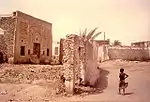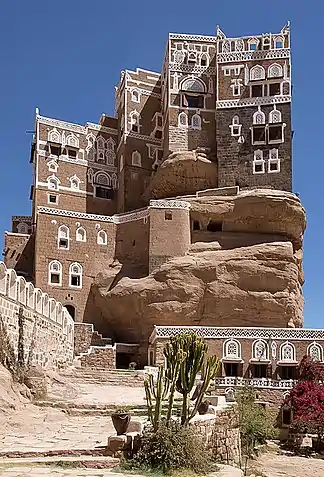Zabid
Zabid (Arabic: زَبِيد) (also spelled Zabīd, Zabeed and Zebid) is a town with an urban population of around 52,590 people, located on Yemen's western coastal plain. It is one of the oldest towns in Yemen, and has been a UNESCO World Heritage Site since 1993. However, in 2000, the site was placed on the List of World Heritage in Danger.
Zabid
زَبِيد | |
|---|---|
Town | |
.jpg.webp)  .jpg.webp)  .jpg.webp) Clockwise from top: Citadel Zabid skyline, Al-Iskanderiya or Citadel Mosque, Administration building within the citadel, architecture pattern, historic town | |
 Zabid Location in Yemen | |
| Coordinates: 14°12′N 43°19′E | |
| Country | |
| Governorate | Al Hudaydah Governorate |
| District | Zabid |
| Time zone | UTC+3 (Yemen Standard Time) |
| Official name | Historic Town of Zabid |
| Criteria | Cultural: (ii), (iv), (vi) |
| Reference | 611 |
| Inscription | 1993 (17th Session) |
| Endangered | 2000–... |
The Great Mosque of Zabid, also known as Al-Asha'ir Mosque, was built in 628 AD by Abu Musa Ashaari, one of the followers of Muhammad. The town was the capital of Yemen from the 13th to the 15th century.
History
The town, named after Wadi Zabid, the wadi (or valley) to its south, is one of the oldest towns in Yemen. Abu Musa Ashaari, one of the Prophet Muhammad's companions, was originally from Zabid, and had the Great Mosque of the town built in 628 AD, during the Prophet's life. According to tradition, this was the fifth mosque built in the history of Islam. Another sahabi, or companion of the Prophet, Amru bin Ma'adi Yakrib, also hailed from Zabid and was from the House of Zubaid, an Arabian tribe named after this city.
Zabid was the capital of Yemen from the 13th to the 15th century. It was known as a center of the Arab and Muslim world, especially for Islamic education, due in large part to its famed University of Zabid. It was the capital of the Ziyadid dynasty from 819 to 1018, and the Najahid dynasty from 1022 to 1158.[1]
In 1067, during the pilgrimage to Mecca, the Banu Najah clan under Sa'id Ibn Najah, the prince of Zabid, attacked the travel party of the Sulayhid sultan, Ali al-Sulayhi, and his wife Asma bint Shihab. They killed Ali and took Asma prisoner. She was sequestered in a secret prison in Zabid, and the severed head of her spouse was reportedly planted on a pole visible from her cell.[2] After a year's imprisonment, she managed to get a message through to her son and daughter-in-law in Sanaa, and her son stormed Zabid and freed her.
Ali ibn Mahdi al-Himyari, a native of the Yemeni highlands, founded the Mahdid dynasty in the Tihama region. Al-Himyari and his followers burned down several districts north of Zabid. He had sworn to put the Abyssinians into slavery and ordered his men to kill everyone, including the handicapped.[3] Out of desperation, the people of Zabid sought assistance from the Zaydi imam Ahmed ibn Sulayman against al-Himyari. The Zaydi imam ordered Fatiq III to be executed on account of his alleged homosexuality. Fatiq III was either killed by the Imam, the Mahdids, or his own soldiers. With this event, the slave dynasty came an end and the Mahdids took over Zabid in 1158.
The troops of Ayyubid prince Turan Shah quickly overran most of Yemen and took Zabid on 13 May 1174.
Hadım Suleiman Pasha extended the Ottoman Empire's authority to include Zabid in 1539.[4] Zabid became the administrative headquarters of Yemen Eyalet.[5]

Today, however, Zabid is at the intellectual and economic margins of modern Yemen.[6] Muhammad Abdul-Wali's novel Sana'a: An Open City tells the story of a young man who traveled to Zabid in the mid-20th century and was surprised to find the town had become a backwater.
Geography
Zabid has an urban population of around 52,590 persons. It is located on Yemen's western coastal plain, in the Tihama region.[7]
World Heritage Site
Zabid was declared a World Heritage Site by UNESCO in 1993.[8] Zabid's Great Mosque occupies a prominent place in the town. The vestiges of its university can also be visited.
In 2000, Zabid was listed on the List of World Heritage in Danger; the listing was made at the behest of the Yemeni government due to a state of poor upkeep and conservation. According to a UNESCO report, roughly "40% of the city's houses have been replaced by concrete buildings, and other houses and the ancient souk are in a deteriorating state.[9][10]
Economy
As of 1920, Zabid was one of two places in Arabia growing indigo. Zabid also grows and produces cotton.[11] The British cite tribal disputes as dampening the economy in Zabid during the early 20th century.[12]
Gallery
 Zabid
Zabid The wall of al-Iskanderiya Mosque
The wall of al-Iskanderiya Mosque Al-Ikanderiya Mosque
Al-Ikanderiya Mosque Street view Zabid
Street view Zabid Damage to historic structure
Damage to historic structure Al-Kamiliya Mosque
Al-Kamiliya Mosque
References
- "Najahid Dynasty." Encyclopædia Britannica Online, 14 April 2006.
- Mernissi, Fatima; Mary Jo Lakeland (2003). The Forgotten Queens of Islam. Oxford University Press. ISBN 978-0-19-579868-5.
- Henry Cassels Kay (1999). Yaman its early medieval history. Adegi Graphics LLC. p. 127. ISBN 1421264641.
- Muḥammad ibn Aḥmad Nahrawālī (2002). Lightning Over Yemen: A History of the Ottoman Campaign in Yemen, 1569–71 [البرق اليماني في الفتح العثماني] (in Arabic). OI.B.Tauris. p. 88. ISBN 1860648363.
- Muḥammad ibn Aḥmad Nahrawālī (2002). Lightning Over Yemen: A History of the Ottoman Campaign in Yemen, 1569–71 [البرق اليماني في الفتح العثماني] (in Arabic). OI.B.Tauris. p. 88. ISBN 1860648363.
- Eickelman, Dale F. "The Middle East and Central Asia." (Prentice Hall, Upper Saddle River: 2002)
- population of Zabid
- "Decision : CONF 002 XI Inscription: Historic Town of Zabid (Yemen)". unesco.org. 1993.
- UNESCO World Heritage Site in Danger 2000: Historic Town of Zabid
- Ahmad al-Aghbari and Mohammad al-Ulofi (February 15, 2009). "Is Yemen Able to Keep Zabid Listed in World Heritage?". Saba News.
- Prothero, G.W. (1920). Arabia. London: H.M. Stationery Office. p. 85.
- Prothero, G.W. (1920). Arabia. London: H.M. Stationery Office. p. 103.
